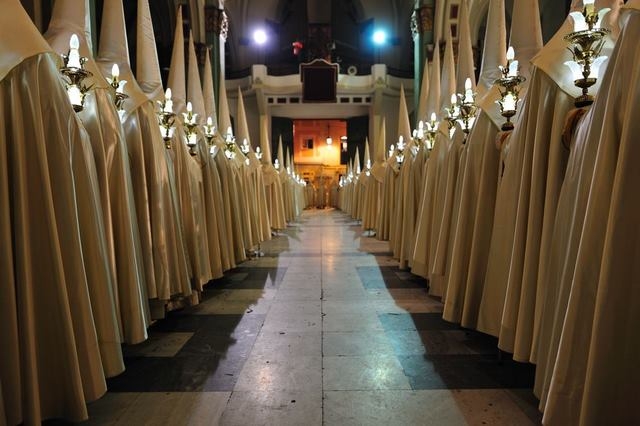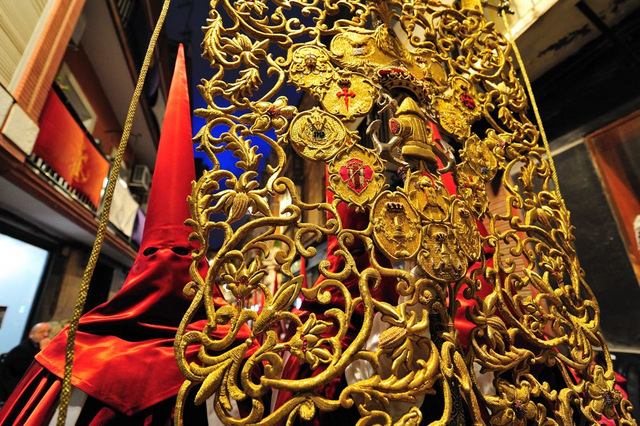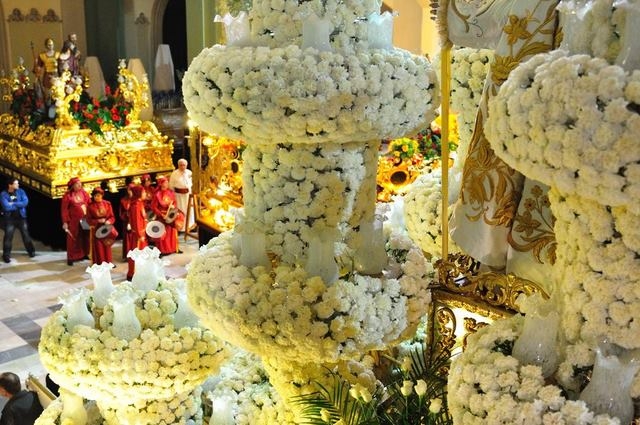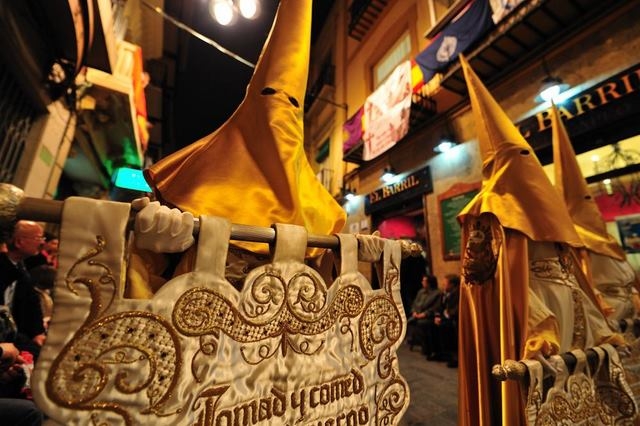-


 Welcome To
Welcome To CARTAGENA
CARTAGENA
 A must do visit
A must do visit The Roman TheatreCartagenaClick Here for more information
The Roman TheatreCartagenaClick Here for more information
 Welcome To
Welcome To CARTAGENA
CARTAGENA article_detail
article_detailSemana Santa Cartagena, Miercoles Santo
Saint Peter and the cockerel, the big night for the Californias
The inexorable and inescapable march towards the crucifixion continues on Miercoles Santo as the Californias take to the streets in the Procesión del Santísimo Cristo del Prendimiento, the capture of Christ.
This is the big day for the Cofradía California, (La Pontificia, Real e Ilustre Cofradía de Nuestro Padre Jesús en el Doloroso paso del Prendimiento y Santo Celo del bien de las Almas) the night on which their Titular, the Paso of the Prendimiento, takes to the streets.
Before the procession a theatrical re-enactment of the trial of Christ is acted out, an event which has been taking place in the City since 1755, albeit in slightly different versions, during which Jesus is taken before Pontius Pilate and tried, before the enactment ends with Pilate washing his hands of the death of Christ by throwing a bowlful of water (cologne) over the assembled crowd. If you go, make sure you´re nowhere near the front!
The procession of the evening leaves from the church of Santa María de Gracia, the first penitent out of the door at 9pm, the last one home not arriving until 3am, a gruelling evening for those charged with ensuring the clockwork smoothness of the procession. It´s quite a feat, the main volume of participants waiting outside in the Plaza san Francisco, called forward to assemble by the rear entrance.
As their turn approaches they gather in a group outside, then are ushered in through the back door, forming into a coloured mass which then slowly spreads into an orderly line.
Once inside the church, they congregate at the back, their drummers waiting near to the door, then called forward fuse into perfect rows, stepping up with hands outstretched to receive a staff, or standard, "dressers" fussing along the rows to ensure capirotes are perfectly straight, silk hanging in a gracious curve, sashes angled to perfection and staffs are lit to just the right degree of brightness.
Out go the band, followed by the perfect rows of shining satin capirotes, staffs clunking on the tiles with military precision as they glide through the church and out into the light where reverent crowds wait for them outside, followed by a gaggle of penitents, pouches stuffed with sweets, and then the star of the show, the paso.

In Cartagena the scale and richness of these pasos, seated on their thrones is overwhelming. Weighing well over a thousand kilos, some 1600 kilos, these are born by upwards of 100 people, enormous structures which tower into the night, elaborate confections of flowers and gilded carvings, each a work of art in its own right.
Inside the church of Santa María de Gracia they´re lined up alongside the walls, the air hazy with the heady columns of incense rising from alongside the entrance, ready to leave with the pasos as they depart from the womb of the church and into the crowded streets outside, bearers taking the strain to lift the trono from its wooden supports at the single ring of a bell. Another ring and they move as one, slowly manoeuvring the enormous trono in line with the door, their exit greeted by ecstatic applause from the crowd.
Swinging around from the door of the church into the narrow street requires precision driving, and there´s no second chance with thousands of eyes judging the progress, many of whom have struggled beneath this burden themselves, and of course, there are always the eyes of the competition.
After all we’re only human.
Be it whos got the best football team, the best dressed trono or who manoeuvred the tightest street corner in Cartagena with the greatest ease, we all have a competitive streak which pushes us to strive for excellence, and there´s more than just pride at stake as these pasos sway through the streets, just inches from the elegant balconies of modernist buildings in historic Cartagena. Competition is fierce between the Cofradías as to who has the best dressed paso and who negotiated the sharp corner without nudging an overhanging balcony.

Saint Peter in Cartagena
One of the greatest pleasures in working throughout the region is uncovering the details of Semana Santa, one such thing being the tradition which revolves around Saint Peter, San Pedro in Cartagena.
The figure of San Pedro is housed in the Military Arsenal all year around, and links back to 1755 when the rigging staff at the Arsenal asked for permission to fund the costs of transporting Saint Peter in the procession. This was granted on one condition, that Saint Peter go on the military payroll, where he remained until a couple of years ago.Each year he is formerly granted leave to attend the Tuesday night procession, but always fails to return during the allotted timescale, so is promptly arrested upon his return to the Arsenal. Following this Wednesday night procession, he is taken back to the Arsenal, to the cracking pace of a pasadoble called "El Gallo, " trying to get him back within the specified timescale, which of course is an impossible quest as he´s already way too late.
El gallo means the cockerel, but is also the name of a popular tune.
Saint Peter appears throughout Semana Santa in the company of a cockerel, having fulfilled the prediction of Jesus that he would deny Jesus three times before the cockerel crowed dawn, a prediction which was fulfilled as three times Peter denied knowing Jesus, fearful for his own life.
He is depicted widely on the Pasos of Semana Santa looking dejected and ashamed, always accompanied by the haunting figure of a crowing cockerel, usually on a column near to his figure.
Popular legend has it that one evening on the hurried journey back to the barracks, the cockerel accompanying Saint Peter on his never ending journey of misery fell off its column and ended up at his feet.

The watching crowd, seeing the falling bird, cried out, "El Gallo, El Gallo, " and the bandmaster, leading the parade, thought they were calling for the pasadoble "El Gallo, " so promptly struck up the request, a tradition which continues to this day.
One further point of interest in this parade is that the brotherhood bearing the Paso of Saint Peter bear their standard cross inverted, and their embroidered sashes and armbands all showed the motif of an inverted cross. The reason for this, we were told, is that Saint Peter was martyred, crucified upside down on a cross as he refused to die as noble a death as his master, so the obliging Romans crucified him upside down to salve his conscience.The Cartagena Californias have one more night of Semana Santa on Thursday, then it´s over and the Marrajas take the stage as the passion unfolds on the night of shame and silence.
article_detail
article_detailContact Spanish News Today: Editorial 966 260 896 / Office 968 018 268

To be listed on the CAMPOSOL TODAY MAP please call +34 968 018 268.

To be listed on the CONDADO TODAY MAP please call +34 968 018 268.

Guidelines for submitting articles to Camposol Today
Hello, and thank you for choosing CamposolToday.com to publicise your organisation’s info or event.
Camposol Today is a website set up by Murcia Today specifically for residents of the urbanisation in Southwest Murcia, providing news and information on what’s happening in the local area, which is the largest English-speaking expat area in the Region of Murcia.
When submitting text to be included on Camposol Today, please abide by the following guidelines so we can upload your article as swiftly as possible:
Send an email to editor@camposoltoday.com or contact@murciatoday.com
Attach the information in a Word Document or Google Doc
Include all relevant points, including:
Who is the organisation running the event?
Where is it happening?
When?
How much does it cost?
Is it necessary to book beforehand, or can people just show up on the day?
…but try not to exceed 300 words
Also attach a photo to illustrate your article, no more than 100kb













